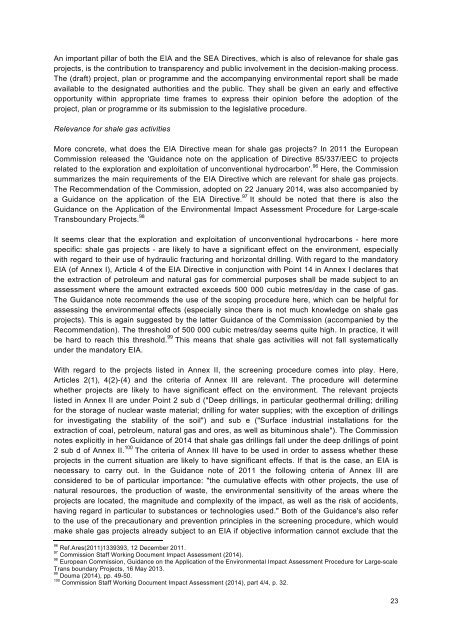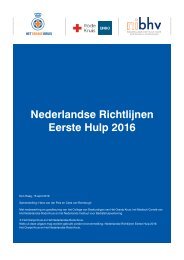Thesis-Anne-Vos-Masters-SBR-and-EU-Law-3
Thesis-Anne-Vos-Masters-SBR-and-EU-Law-3
Thesis-Anne-Vos-Masters-SBR-and-EU-Law-3
Create successful ePaper yourself
Turn your PDF publications into a flip-book with our unique Google optimized e-Paper software.
An important pillar of both the EIA <strong>and</strong> the SEA Directives, which is also of relevance for shale gas<br />
projects, is the contribution to transparency <strong>and</strong> public involvement in the decision-making process.<br />
The (draft) project, plan or programme <strong>and</strong> the accompanying environmental report shall be made<br />
available to the designated authorities <strong>and</strong> the public. They shall be given an early <strong>and</strong> effective<br />
opportunity within appropriate time frames to express their opinion before the adoption of the<br />
project, plan or programme or its submission to the legislative procedure.<br />
Relevance for shale gas activities<br />
More concrete, what does the EIA Directive mean for shale gas projects? In 2011 the European<br />
Commission released the 'Guidance note on the application of Directive 85/337/EEC to projects<br />
related to the exploration <strong>and</strong> exploitation of unconventional hydrocarbon'. 96 Here, the Commission<br />
summarizes the main requirements of the EIA Directive which are relevant for shale gas projects.<br />
The Recommendation of the Commission, adopted on 22 January 2014, was also accompanied by<br />
a Guidance on the application of the EIA Directive. 97 It should be noted that there is also the<br />
Guidance on the Application of the Environmental Impact Assessment Procedure for Large-scale<br />
Transboundary Projects. 98<br />
It seems clear that the exploration <strong>and</strong> exploitation of unconventional hydrocarbons - here more<br />
specific: shale gas projects - are likely to have a significant effect on the environment, especially<br />
with regard to their use of hydraulic fracturing <strong>and</strong> horizontal drilling. With regard to the m<strong>and</strong>atory<br />
EIA (of <strong>Anne</strong>x I), Article 4 of the EIA Directive in conjunction with Point 14 in <strong>Anne</strong>x I declares that<br />
the extraction of petroleum <strong>and</strong> natural gas for commercial purposes shall be made subject to an<br />
assessment where the amount extracted exceeds 500 000 cubic metres/day in the case of gas.<br />
The Guidance note recommends the use of the scoping procedure here, which can be helpful for<br />
assessing the environmental effects (especially since there is not much knowledge on shale gas<br />
projects). This is again suggested by the latter Guidance of the Commission (accompanied by the<br />
Recommendation). The threshold of 500 000 cubic metres/day seems quite high. In practice, it will<br />
be hard to reach this threshold. 99 This means that shale gas activities will not fall systematically<br />
under the m<strong>and</strong>atory EIA.<br />
With regard to the projects listed in <strong>Anne</strong>x II, the screening procedure comes into play. Here,<br />
Articles 2(1), 4(2)-(4) <strong>and</strong> the criteria of <strong>Anne</strong>x III are relevant. The procedure will determine<br />
whether projects are likely to have significant effect on the environment. The relevant projects<br />
listed in <strong>Anne</strong>x II are under Point 2 sub d ("Deep drillings, in particular geothermal drilling; drilling<br />
for the storage of nuclear waste material; drilling for water supplies; with the exception of drillings<br />
for investigating the stability of the soil") <strong>and</strong> sub e ("Surface industrial installations for the<br />
extraction of coal, petroleum, natural gas <strong>and</strong> ores, as well as bituminous shale"). The Commission<br />
notes explicitly in her Guidance of 2014 that shale gas drillings fall under the deep drillings of point<br />
2 sub d of <strong>Anne</strong>x II. 100 The criteria of <strong>Anne</strong>x III have to be used in order to assess whether these<br />
projects in the current situation are likely to have significant effects. If that is the case, an EIA is<br />
necessary to carry out. In the Guidance note of 2011 the following criteria of <strong>Anne</strong>x III are<br />
considered to be of particular importance: "the cumulative effects with other projects, the use of<br />
natural resources, the production of waste, the environmental sensitivity of the areas where the<br />
projects are located, the magnitude <strong>and</strong> complexity of the impact, as well as the risk of accidents,<br />
having regard in particular to substances or technologies used." Both of the Guidance's also refer<br />
to the use of the precautionary <strong>and</strong> prevention principles in the screening procedure, which would<br />
make shale gas projects already subject to an EIA if objective information cannot exclude that the<br />
96<br />
Ref.Ares(2011)1339393, 12 December 2011.<br />
97<br />
Commission Staff Working Document Impact Assessment (2014).<br />
98<br />
European Commission, Guidance on the Application of the Environmental Impact Assessment Procedure for Large-scale<br />
Trans boundary Projects, 16 May 2013.<br />
99<br />
Douma (2014), pp. 49-50.<br />
100<br />
Commission Staff Working Document Impact Assessment (2014), part 4/4, p. 32.<br />
23



